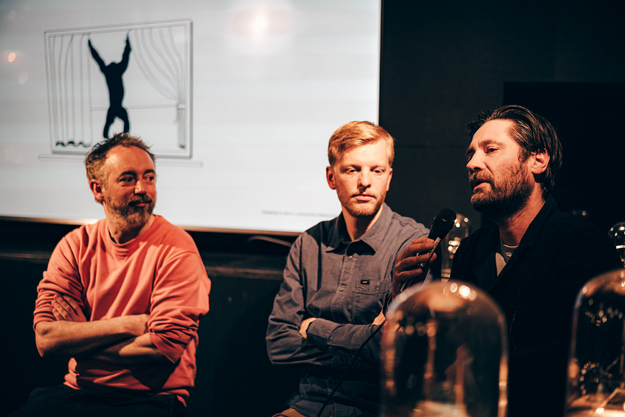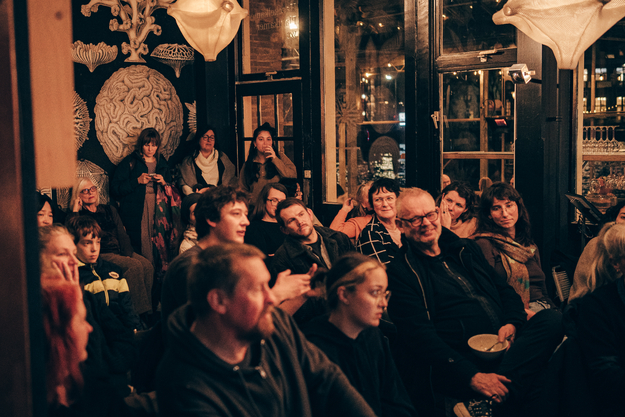There is so much that we can learn from nature and how we can grow and live together with it. This is part of the idea of what started the Tower Talks. Arne, who has been building living mycelium towers at Mediamatic for over four years now, invites individuals who can tell us more about this idea and how they incorporate it into their various fields of expertise. For this evening, we spoke with Thijs, who designed the new elephant and lion enclosures at Artis and with urban ecologist Atze van der Goot. The talk focused on the idea of living together with nature, primarily when it comes to animals, both those that are native to where we live and those that were transplanted here at one point.
Thijs is a landscape architect, but also a self-proclaimed nature optimist. He started his talk by introducing the idea of the city as a zoo through a short history of living together that goes back thousands of years.
This idea of the city as our shared habitat goes back around 6000 years to Ancient Egypt. This was when humans first welcomed cats into their lives, creating a bond that continues to this day. But it was not just cats, our urban landscapes have long been intertwined with various forms of wildlife, where animals roamed freely among us, finding solace in our midst. Thijs delves further into the history, going back around 2 million years to the era of Australopithecus. Symbols relating to the Australopithecus can still be found in many modern day zoos. With this, Thijs emphasises the need for coexistence between humans and our natural predators, especially in cities located in biodiversity hotspots.
As our cities continue to expand, we encroach further into the territories of various animals. For this reason, we must learn to navigate this shared space, along with finding ways to deal with the risks and conflicts that may arise due to them. In relation to this, Thijs brings up the concept of barriers. As some may know, there is a plan to build a fence around Friesland to keep the wolf out. A fence is a very interesting way to live together, as it allows both species to get very close without being able to harm each other. The fence is also problematic, of course. There is a paradox in fences as they give us proximity to something while maintaining a barrier to it. This reflects the complexity of our relationship with nature. We want to create and maintain connections with nature, yet at the same time impose limitations that go against its inherent spontaneity.
Thijs has been working on the captive side for some time, designing animal enclosures in the Amsterdam Zoo. This involves creating environments that would not otherwise be found in Amsterdam for animals that would also not otherwise be found here. The whole animal population of the zoo lives in little islands created to imitate various places from around the world. In his work, Thijs aims to recreate diverse ecosystems within the urban landscape, creating a place for animals that have been removed from their natural habitats. His aim is not only to confine but to also enrich the lives of the animals. Each enclosure he creates aims to create a sense of understanding and appreciation for the natural world, bridging the gap between the urban and the wild. Despite the fact that enclosures are designed in the attempts to allow animals to live naturally, Thijs acknowledges the fact that there is nothing natural about this situation. It seems as if the animals are aware of this abnormal situation however, their behaviour may not be completely natural, but instead logical and useful for their existence.“But all these animals that move into the cities, into our urban environment, adapt and they become also urban dwellers.” Thijs continues.
Zoos are spaces that blur the boundaries between human and animal environments, creating tensions as well as unique interactions. They serve as spaces for imagination and experimentation surrounding the relationships between humans and animals, challenging visitors to reconsider their roles in these spaces.
There are various anecdotes that help to illustrate how non-human species can adapt to urban environments, such as chimpanzees catching woodpeckers and herons thriving in cities due to changes in their natural habitats. Examples such as these encourage reflections on the evolving relationship between wildlife and humans, highlighting the need to rethink traditional conservation approaches.
One of the reasons that Atze, along with some of his friends who are also ecologists, started exploring green spaces within the city more was due to the COVID-19 restrictions a few years ago. Since they were unable to travel at the time, they decided to take their cameras around Amsterdam and explore some of the city’s parks. They were greatly surprised and amazed by the variety of things that they found that they started thinking about nature from a different perspective.
The idea of the city as a zoo suggests that urban spaces should accommodate diverse species and ecosystems, in the same way that traditional zoos do. This means reimagining urban design in a way that makes it more inclusive of wildlife and incorporating more green spaces into city planning.
Important questions and concerns were also raised by audience members. The topics brought up included ethical concerns, financial limitations, and social responsibility.
There are also ethical considerations when it comes to inviting and accommodating wildlife in urban areas. While some advocate for a hands-off approach, allowing species to naturally colonise cities, others argue that we should instead intervene more in creating habitats and supporting biodiversity. There is also a tension between observation and activism and it is important to find a balance between preserving ecosystems and allowing natural processes to take place.
There is of course also financial implications when it comes to the idea of transforming cities into more hospitable environments for wildlife. This is also of course in tension with the housing crisis, homeless populations, and increasing numbers of displaced peoples.
The talk concluded with a call for social engagement and legislative action that would help prioritise wildlife conservation in urban planning. This could include integrating more ecological principles into city laws and increasing public awareness and support for wildlife-friendly efforts. Overall, there is a need for a shift in how we perceive and interact with our urban environments, based on a more harmonious coexistence between humans and wildlife.

